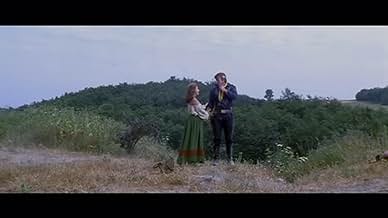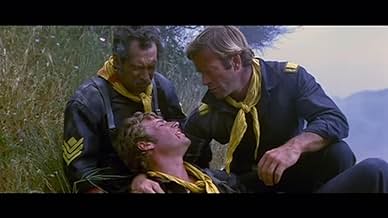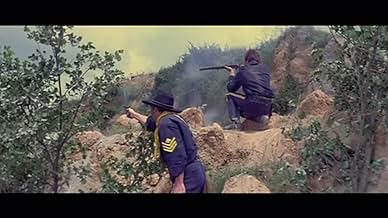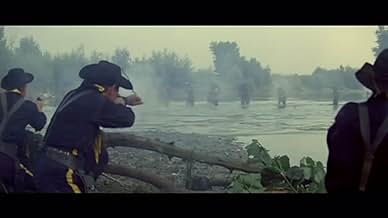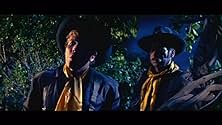अपनी भाषा में प्लॉट जोड़ेंA lone rider comes across a dying soldier, who gives him a paper authorizing the payment of $150,000 to the U.S. Army. The rider gathers some colleagues who disguise themselves as soldiers a... सभी पढ़ेंA lone rider comes across a dying soldier, who gives him a paper authorizing the payment of $150,000 to the U.S. Army. The rider gathers some colleagues who disguise themselves as soldiers and who take the paper to a bank.A lone rider comes across a dying soldier, who gives him a paper authorizing the payment of $150,000 to the U.S. Army. The rider gathers some colleagues who disguise themselves as soldiers and who take the paper to a bank.
Alberto Cevenini
- Slim Kincaid
- (as Kirk Bert)
Gustavo De Nardo
- Sergeant Warwick
- (as Dean Ardow)
- …
Antonio Gradoli
- Captain Hull
- (as Anthony Gradwell)
- …
Gérard Herter
- Mr. Silver
- (बिना क्रेडिट के)
Claudio Ruffini
- Sandy-Haired Gambler
- (बिना क्रेडिट के)
Pietro Tordi
- Bartender
- (बिना क्रेडिट के)
फ़ीचर्ड समीक्षाएं
I've only seen each of the 3 Bava spaghetti westerns once (neither among his best work or his preferred genre), but I disagree with many people who considered Nebraska Jim to be a better film. Strictly from an entertainment sense, Arizone Bill (La Strada per Fort Alamo) held my interest noticeably better (though admittedly the copy of Nebraska Jim that I saw had severely distraction issues with audio). While Nebraska Jim seemed like a mostly cookie cutter extended western TV show episode you'd expect to see on American TV, Arizona Bill was more like a 2nd rate Good Bad and Ugly wannabe with its stolen civil war funds plot line and a group of criminals that ranges from a couple of more 'decent' people who are criminals to outright despicable violent ones. It was just slightly different enough to make it more interesting to me and it felt more like a Bava film. Maybe if I rewatch these films a few more times I'll notice things I've overlooked which will explain others' preferences, but I'm a bit skeptical that that will happen.
It's not the greatest or most original film, but it kept me entertained and my biggest complaint is with regards to the 'romantic' subplot and its cheesy accompanying music (at least on the copy I saw, I'm not sure if it was or wasn't the original music used). Bava isn't always at his best when trying to provide romance/love interests to his films. Black Sunday (La Maschera del demonio) is IMHO the quintessential Italian Gothic horror film and a favorite of mine, but even his admirers have to admit that in that great film, the 'undying love' of the young Dr. Gorobec for Katia -- whom he has just met one day previous -- is a bit silly and one-dimensional and at times almost laughably overly melodramatic. I took off one point for the botched romance portions of Arizona Bill, though I did like it overall more than Nebraska which ended up with the same 5/10 score from me.
The copy of the film I saw was an English language widescreen version from an old somewhat glitchy videotape source with a runtime closer to the USA or German cuts. I'm not sure what was excised from the original 90 minute cut listed on IMDb and maybe when TL's big Bava book comes out it will tell us what is or isn't missing from the cut I saw, but I hope one of the cult DVD companies (like Image, Anchor Bay or Blue Underground) pick up both this title and "Nebraska Jim" sometime in the near future to provide Bava's fans with a good legitimate uncut DVD release with the best transfer possible considering whatever film elements exist. I'm sure the underrated director's fans would welcome quality releases of all his films, even the lesser known and hard to find ones where Mario took over directorial duties from a previous director leaving a project.
It's not the greatest or most original film, but it kept me entertained and my biggest complaint is with regards to the 'romantic' subplot and its cheesy accompanying music (at least on the copy I saw, I'm not sure if it was or wasn't the original music used). Bava isn't always at his best when trying to provide romance/love interests to his films. Black Sunday (La Maschera del demonio) is IMHO the quintessential Italian Gothic horror film and a favorite of mine, but even his admirers have to admit that in that great film, the 'undying love' of the young Dr. Gorobec for Katia -- whom he has just met one day previous -- is a bit silly and one-dimensional and at times almost laughably overly melodramatic. I took off one point for the botched romance portions of Arizona Bill, though I did like it overall more than Nebraska which ended up with the same 5/10 score from me.
The copy of the film I saw was an English language widescreen version from an old somewhat glitchy videotape source with a runtime closer to the USA or German cuts. I'm not sure what was excised from the original 90 minute cut listed on IMDb and maybe when TL's big Bava book comes out it will tell us what is or isn't missing from the cut I saw, but I hope one of the cult DVD companies (like Image, Anchor Bay or Blue Underground) pick up both this title and "Nebraska Jim" sometime in the near future to provide Bava's fans with a good legitimate uncut DVD release with the best transfer possible considering whatever film elements exist. I'm sure the underrated director's fans would welcome quality releases of all his films, even the lesser known and hard to find ones where Mario took over directorial duties from a previous director leaving a project.
Director Mario Bava usually has a visual flair which helps elevate his movies above their "Grade B" genres. He doesn't seem to have his heart in this project, however. It plays out in a routine fashion and about the only scene which might linger in the memory has the Indians putting dollar bills adrift in a river in order to lure cavalry soldiers out into the open. Ken Curtis, who always deserved better, makes an attractive hero but the script gives him little to work with.
Here Mario Bava , Master of the Macabre goes west in this exciting story dealing with Bill Mannerly : Ken Clark , who comes across a dying Northern Soldier who gives him a document authorizing the payment a large sum of money .The drifter joins some pals and all of them posing as soldiers to take the money at a bank . After that , they join up with US cavalry sent to pacify Indian tribes . Along the way he falls in love for a gorgeous prisoner called Janet : Jany Clair imprisoned in a wagon. Then, there takes places a series of incidents , including Indian attacks , fights , duels , assaults and anything else .The Adventure ...the violence ...of the savage West ¡
This is an ordinary Western about a simple and plain plot in which has great importance the regular confrontation between Cavalry and Indians . This good-natured Pasta Western contains thrills , romance , shootouts , crosses and double-crosses and action enough. It results to be quite entertaining but middling . Stars Ken Clark as an ambitious lone rider falling in love for beautiful Jany Clair and thanks to her he finds redemption, both of whom also starred Agent Secret FX 18 (1964) . Ken Clark was one of many American hunk men as Steve Reeves , Gordon Scott , Reg Park, Mark Forest , Reg Lewis, Dan Vadis , Rock Stevens , Lou Ferrigno, emigrated to Italy to play a Sword and Sandals or Peplum movies , though none of them topped in popularity to Steve Reeves . As Ken Clark getting a certain success in Peplum , and Euro-spy genre . Here Ken Clark is accompanied by a functional support cast , but none of them are known Western secondaries , exception for Gerard Herter who starred some classic Spaghetti Western . I miss the familiar faces regular in Spaghetti/Chorizo sub-genre . In "Road to Fort Alamo" stands out the splendid photography by Ubaldo Terzano and Mario Bava himself , full of brilliant blue and yellow colors, being shot in Elios studios , and exteriors from Lazio , Rome . As well as atmospheric musical score in Spaghetti style by Piero Umiliani.
The picture was regular but professionally directed by Mario Bava. He was the main creator of Italian Giallo genre , Bava (Blood and Black Lace, House of Exorcism, Black Sabbath) along with Riccardo Freda (Secret of Dr Hitchcock) and subsequently Dario Argento (Suspiria, Tenebre , Phenomena) are the fundamental representatives .In fact , Bava and Freda had a long collaboration , as Bava finished two Riccardo's films : Il Vampiri and Caltiki . These Giallo movies are featured by overblown use of color in shining red blood, usual zooms, and regular images-shock. Bava made all kinds of genres , such as Scifi : "Planet of vampires" , Peplum : "Hercules in the Center of Earth" , "Battle of Marathon", Historical : "Erik the Conqueror", "Viking massacre"and Spaghetti Western : "Roy Colt and Winchester Jack", "Ringo From Nebraska" codirected by Antonio Roman and this "Road to Fort Alamo". The movie will appeal to Mario Bava enthusiasts and completists.
This is an ordinary Western about a simple and plain plot in which has great importance the regular confrontation between Cavalry and Indians . This good-natured Pasta Western contains thrills , romance , shootouts , crosses and double-crosses and action enough. It results to be quite entertaining but middling . Stars Ken Clark as an ambitious lone rider falling in love for beautiful Jany Clair and thanks to her he finds redemption, both of whom also starred Agent Secret FX 18 (1964) . Ken Clark was one of many American hunk men as Steve Reeves , Gordon Scott , Reg Park, Mark Forest , Reg Lewis, Dan Vadis , Rock Stevens , Lou Ferrigno, emigrated to Italy to play a Sword and Sandals or Peplum movies , though none of them topped in popularity to Steve Reeves . As Ken Clark getting a certain success in Peplum , and Euro-spy genre . Here Ken Clark is accompanied by a functional support cast , but none of them are known Western secondaries , exception for Gerard Herter who starred some classic Spaghetti Western . I miss the familiar faces regular in Spaghetti/Chorizo sub-genre . In "Road to Fort Alamo" stands out the splendid photography by Ubaldo Terzano and Mario Bava himself , full of brilliant blue and yellow colors, being shot in Elios studios , and exteriors from Lazio , Rome . As well as atmospheric musical score in Spaghetti style by Piero Umiliani.
The picture was regular but professionally directed by Mario Bava. He was the main creator of Italian Giallo genre , Bava (Blood and Black Lace, House of Exorcism, Black Sabbath) along with Riccardo Freda (Secret of Dr Hitchcock) and subsequently Dario Argento (Suspiria, Tenebre , Phenomena) are the fundamental representatives .In fact , Bava and Freda had a long collaboration , as Bava finished two Riccardo's films : Il Vampiri and Caltiki . These Giallo movies are featured by overblown use of color in shining red blood, usual zooms, and regular images-shock. Bava made all kinds of genres , such as Scifi : "Planet of vampires" , Peplum : "Hercules in the Center of Earth" , "Battle of Marathon", Historical : "Erik the Conqueror", "Viking massacre"and Spaghetti Western : "Roy Colt and Winchester Jack", "Ringo From Nebraska" codirected by Antonio Roman and this "Road to Fort Alamo". The movie will appeal to Mario Bava enthusiasts and completists.
Italian movie director Mario Bava is best known for his horror movies. But during his career he found time to direct other kinds of movies, including spaghetti westerns, "The Road To Fort Bravo" being one such example. The movie is pretty unknown, and it's easy to see why. Throughout it has the feeling of a slapdash production. The budget was obviously pretty low, so the production values are pretty tacky, from the costumes to the poor special effects. Bava seems unable to show any visual flair on this project, except for a few scenes that take place in caves. But the main problem with the movie is the script. It feels like a first draft, with many scenes feeling rushed or unfinished. This quickie enterprise is capped with a pretty bad musical score by Piero Umiliani, which consists of 60s style music at its worst. The best that can be said of the movie is that its running time is fairly short.
I think the thing that impressed me the most about Mario Bava's first spaghetti western outing here is how utterly pedestrian most of the proceedings were. Another distinguished commentator here has it right: This is the Italo western boys before the spaghetti idiom was truly established dressing up in their snappy cavalry duds & playing cowboys and Indians just like we used to do out at the sandlot near my cousin's summer house, only we didn't have such nice costumes.
Ken Clark is a decent enough he-man leading heroic noble Shatterhand type, apparently roaming the west looking for trouble to straighten out. He finds it when a young novice finds himself taken by a card shark (the priceless Gerard Herter, Max from CALTIKI) and the two have to fight their way out of town & take up with a band of rogues who are targeting a bank to knock over. For reasons that escape me they find themselves mistaken for cavalry officers and join up with a U.S. Army element sent to the region to pacify the local Indian tribes so that the nice Caucasian people can build towns, railroads, brothels, and prosper without having to take the local Natives into consideration.
It's pretty much the usual stuff for a low budget early 1960s western and indeed the story is decidedly lacking on the traditional spaghetti western histrionics, which many fans may be disappointed by. I however got a kick out of seeing Mario Bava constrained to a pretty straight forward story, complete with a heroic ride to the rescue at the end with the bugles & everything. If it sounds like a let down, students of Bava's unique visual style will actually be pleased with a series of nighttime scenes obviously filmed on a sound stage with that traditional Bava artsy minimalism emphasizing color and texture over rugged authenticity. This was made in the period before Sergios Leone and Corbucci more or less invented the spaghetti aesthetic, qualifying it more as a Euro western than a proper spaghetti outing. The film is also somewhat unique in that like Joe Lacey's FURY OF THE APACHES it actually involves the Native American peoples -- albeit somewhat clumsily and in a stereotypical fashion -- rather than swarthy Pistoleros shooting at Clint Eastwood's mule.
I found it to be a fascinating movie perfect for a snowed in Saturday afternoon, though some may question how convinced Bava was of his own artistic vision for the movie. It's more sort of a compromise between his KILL BABY KILL cinematics and traditionalist Oater mentalities, with some truly stunning shots framed when seen in the proper widescreen ratio. The one thing I kept thinking is that here is a surprisingly ordinary low budget western that's been photographed like a Gothic study in spots, and the rather bloodless nature of the goings on mean that it's a rare example of an Italo western that was meant for all ages rather than a grim cartoon for adults. I kind of like it, and found it a much more rewarding viewing experience than Bava's 1970 final spaghetti ROY COLT & WINCHESTER JACK, though fans of the genre will probably prefer his NEBRASKA JIM.
6/10
Ken Clark is a decent enough he-man leading heroic noble Shatterhand type, apparently roaming the west looking for trouble to straighten out. He finds it when a young novice finds himself taken by a card shark (the priceless Gerard Herter, Max from CALTIKI) and the two have to fight their way out of town & take up with a band of rogues who are targeting a bank to knock over. For reasons that escape me they find themselves mistaken for cavalry officers and join up with a U.S. Army element sent to the region to pacify the local Indian tribes so that the nice Caucasian people can build towns, railroads, brothels, and prosper without having to take the local Natives into consideration.
It's pretty much the usual stuff for a low budget early 1960s western and indeed the story is decidedly lacking on the traditional spaghetti western histrionics, which many fans may be disappointed by. I however got a kick out of seeing Mario Bava constrained to a pretty straight forward story, complete with a heroic ride to the rescue at the end with the bugles & everything. If it sounds like a let down, students of Bava's unique visual style will actually be pleased with a series of nighttime scenes obviously filmed on a sound stage with that traditional Bava artsy minimalism emphasizing color and texture over rugged authenticity. This was made in the period before Sergios Leone and Corbucci more or less invented the spaghetti aesthetic, qualifying it more as a Euro western than a proper spaghetti outing. The film is also somewhat unique in that like Joe Lacey's FURY OF THE APACHES it actually involves the Native American peoples -- albeit somewhat clumsily and in a stereotypical fashion -- rather than swarthy Pistoleros shooting at Clint Eastwood's mule.
I found it to be a fascinating movie perfect for a snowed in Saturday afternoon, though some may question how convinced Bava was of his own artistic vision for the movie. It's more sort of a compromise between his KILL BABY KILL cinematics and traditionalist Oater mentalities, with some truly stunning shots framed when seen in the proper widescreen ratio. The one thing I kept thinking is that here is a surprisingly ordinary low budget western that's been photographed like a Gothic study in spots, and the rather bloodless nature of the goings on mean that it's a rare example of an Italo western that was meant for all ages rather than a grim cartoon for adults. I kind of like it, and found it a much more rewarding viewing experience than Bava's 1970 final spaghetti ROY COLT & WINCHESTER JACK, though fans of the genre will probably prefer his NEBRASKA JIM.
6/10
क्या आपको पता है
- गूफ़Bill rides up to dead soldiers at the beginning. He resumes riding in the direction he was going, but in the next shot the scenery is that of the opposite direction - where he'd just been.
- भाव
[surrounded by Ozark Indians]
Bud Massedy: We've no hope at all.
- कनेक्शनReferenced in Mario Bava: Maestro of the Macabre (2000)
- साउंडट्रैकThe Way To Alamo
Performed by Tony Wendell
टॉप पसंद
रेटिंग देने के लिए साइन-इन करें और वैयक्तिकृत सुझावों के लिए वॉचलिस्ट करें
विवरण
इस पेज में योगदान दें
किसी बदलाव का सुझाव दें या अनुपलब्ध कॉन्टेंट जोड़ें

टॉप गैप
By what name was La strada per Forte Alamo (1964) officially released in Canada in English?
जवाब
